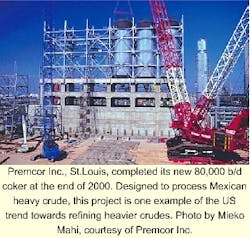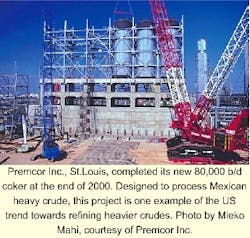Changing crudes, fuel standards will drive future refining investment
Future worldwide refining investment will be in response to three trends in the industry: heavier and increasingly sour crude oil processing, greater need for desulfurization, and the reduction of methyl tertiary butyl ether (MTBE) use in the US.
Especially in the US, refiners are making lighter fuels with heavier crudes. Widening light and heavy crude price differentials and higher crude prices encourage refiners to run lower-cost heavy and sour crudes.
In addition, worldwide fuel regulations, especially for sulfur, are becoming more stringent. Refiners must increase hydrodesulfurization capacity to stay in business. Additional hydroprocessing capacity will be largely responsible for most refinery configurational changes in the next year.
Finally, in the next 2-5 years, US refiners will be looking for a substitute for octane provided by MTBE. In other countries, just the opposite will happen: the elimination of lead from their fuel stock will drive them to consider MTBE.
Heavier crude oil processing
In the past 5 years, US refineries have modified their plants to accommodate lower-cost heavy and sour crudes. This trend will continue this year, highlighted by crude distillation, hydrocracker, and coker projects.
In US refineries, heavy and sour crudes come mainly from Canada, Venezuela, Mexico, California, and the Middle East. Europe and Asia generally tend to process more lighter, sweeter crudes than the US. Europe will likely continue to do this until margin incentives increase.
Sinopec Corp., Beijing, has indicated it will seek heavier, more-sour crudes in the future to reduce crude costs. According to a report by Credit Suisse First Boston Corp., New York, Sinopec is planning to invest more than $1 billion in its refineries during 2001-03 so that it can process more high sulfur crudes.
In the recent past, many refineries have added cokers and modified crude distillation units to accommodate heavier crudes.
In April 1999, then-BP Amoco's Toledo, Ohio, refinery commissioned a coker unit so that it could process sour crude from Canada. In the same year, then-Mobil Corp. modified its crude distillation unit to handle Orinoco crude from Petroleos de Venezuela SA (PDVSA).
PDVSA also has an alliance with Phillips Petroleum Co.'s Sweeny, Tex., refinery. Last year, Phillips and PDVSA built a 58,000 b/d coker at Phillips's Sweeny complex to handle heavy Venezuelan crude for 20 years.
Like PDVSA, Petroleos Mexicanos (Pemex) has actively sought outlets for its crude in the US.
Both Coastal Corp. and Premcor Inc. completed new delayed coking units this year to handle Mexican crude. Coastal built a 30,000 b/d unit in its Aruba refinery, and Premcor built an 80,000 b/d unit in its Port Arthur, Tex., refinery.
By mid-2001, Shell Oil Co.'s Deer Park, Tex., refinery expects to have completed a project to expand its crude and coke processing facilities. The project will allow the refinery to process another 60,000 b/d of Maya crude oil.
Valero Corp., after it acquired ExxonMobil Corp.'s Benicia, Calif., refinery, announced it wants to increase the refinery's heavy crude processing capacity. At present, the plant processes 30,000 b/d of heavy, sour crude oil, primarily from California's San Joaquin Valley. Valero hopes to process 50,000 b/d in the next 2 years, decreasing its reliance on more-expensive Alaskan North Slope crude oil.
According to OGJ's biennial construction survey (OGJ, Oct. 30, 2000, p. 59), there will be about 83,000 b/d of coking capacity in the US built in 2001, all on the Gulf Coast. Outside of the US, OGJ expects 550,000 b/d of delayed coking capacity to come on stream by 2004, most of this from Canada's oil sands and Venezuela's Orinoco heavy oil projects.
Gasoline and diesel standards
In late 1999, the US Environmental Protection Agency began to implement a rule to tighten average US gasoline sulfur content to 30 ppm from 300 ppm, beginning in 2005 (OGJ, Jan. 3, 2000, p. 26). These new regulations, combined with the tendency of US refiners to process more sour crudes, will require refiners to optimize sulfur-reducing processes and to invest in sulfur-reducing technologies.
Although not yet finalized, US EPA proposed a rule this past May to reduce the cap on US diesel sulfur to 15 ppm from 500 ppm by June 1, 2006. The standard is intended to meet Tier 2 standards for nitrogen oxides and particulate matter.
Canada's EPA has purposely aligned its fuel goals to that of the US. It is reducing sulfur content limits in gasoline to 30 ppm by 2005 and proposes to reduce sulfur in diesel to 15 ppm by 2007.
The European Commission has already mandated a 50-ppm maximum sulfur content for both gasoline and diesel by 2005. It is discussing further reductions, however (OGJ, Nov. 27, 2000, p. 64).
Although countries such as Russia and China have more lenient fuel specifications, their fuel standards will also be tightened, and they will require new refining investment.
By Jan. 1, 2003, gasoline sold in all of China's cities will have an allowable maximum sulfur content of 800 ppm.
Credit Suisse First Boston reported that Sinopec, which owns about 48% of China's crude processing capacity, will invest about $900 million in its refineries during 2001-03 to improve its fuel product qualities.
Australia plans to limit its diesel sulfur content to 50 ppm in 2006, and Japan is talking about the same limit for 2005.
More desulfurization units
Because about 80% of the sulfur in the gasoline pool comes from fluid catalytic cracking units (FCCU), methods to reduce sulfur have focused on treating the feed to the FCCU or treating the gasoline from the FCCU.
Refiners can also reduce the gasoline endpoint to meet specifications, although this will reduce yields. Optimization of existing operations and catalysts will also help refiners reduce sulfur from their products.
The advantage of hydrotreating the feed to the FCCU is that it significantly reduces the sulfur concentration in the FCCU gasoline and reduces sulfur oxides from the FCCU. It reduces sulfur at the expense of octane number, however, and is expensive because it requires hydrogen and severe operating conditions.
Treating just the gasoline from the FCCU, on the other hand, requires a smaller capital investment, allows smaller volumes of product to be treated, and consumes less hydrogen.
There are several offerings from technology licensors to provide refineries with traditional hydrotreating and newer gasoline desulfurization alternatives. For hydrotreating, these technologies come from companies such as Chevron Corp., Institut Fran
Diesel technology providers include Criterion Catalyst & Technologies, Haldor Topsoe Inc., IFP, Phillips, UOP, and an alliance among ExxonMobil, Akzo Nobel Chemicals Inc., Halliburton Co.'s Kellogg Brown & Root, and Fina Research AS.
Several operating companies have already announced a significant number of new hydrotreating projects. OGJ's last construction survey reported about 1.6 million b/d of new hydrotreating capacity to come on stream during 2001-04.
Oxygenates standards
Maintaining desired product qualities in the US will become more difficult if reducing the sulfur from gasoline is accompanied by a phase-out of MTBE. MTBE is an oxygenate that boosts the octane in gasoline, lowers carbon monoxide emissions, and displaces undesirable components such as aromatics and sulfur.
Although MTBE seems to be on its way out in the US, other countries have not followed the US lead. Neither the European Commission nor any Asian countries plan to phase out MTBE. These countries have no oxygenate requirements and use MTBE in much smaller quantities than the US, mainly as an octane booster and substitute for benzene.
In fact, as the US phases out MTBE from its demand in the next decade, other parts of the world will likely increase their MTBE demand.
The US requires its reformulated gasoline (RFG), which accounts for about one third of the total gasoline market in the US, to contain at least 2 wt % oxygen. MTBE is used in more than 85% of US RFG.
MTBE, however, has fallen from the public's grace because it has been detected in 5-10% of drinking water supplies in areas using RFG or oxygenated fuel in the US. Although most of these detections have not been a threat to public health, taste and odor concerns and misperceptions about the magnitude of MTBE contamination have prompted outcries to eliminate MTBE.
California's Phase III gasoline regulations prohibit the use of MTBE in its RFG beginning Dec. 31, 2002. The US East Coast is similarly working to eliminate MTBE.
MTBE substitutes
Although the outcome of MTBE for the rest of the US is not known, US refiners are considering processes that will replace the lost octane and lost volume that a ban on MTBE would cause.
If US EPA waives the federal oxygenates standard, refiners will have more flexibility and will seek alternatives such as ethers, alcohols, alkylate, and reformate.
Ethers, such as tertiary amyl methyl ether (TAME) and ethyl tertiary butyl ether (ETBE), have the same unknown health effects and environmental concerns as MTBE and therefore are not good replacements.
If the oxygenates standard is not waived, ethanol is the most likely oxygenate to replace MTBE. Ethanol is currently used in about 8% of RFG in the US.
Alkylate is an ideal blending component because it lacks aromatics, olefins, and sulfur, and has good octane and Reid vapor pressure characteristics. Reformate is also good, but it has a high aromatics content.
Refiners may respond to octane needs by adding alkylation, isomerization, or reforming capacity. Supporting units, such as naphtha hydrotreaters and sulfur plants, may also be necessary. Expanding the alkylation unit also means expanding associated mercaptan removal and selective hydrogenation units.
Should ethanol be produced as an oxygenate, the refinery would need to add a depentanizer to remove pentanes from the light straight run to compensate for the increased Reid vapor pressure.
Even with the use of ethanol-because ethanol will be added by a volume of 6% rather than 11%-and because pentanes will be removed, other gasoline blending components will be needed to make up lost volumes.

